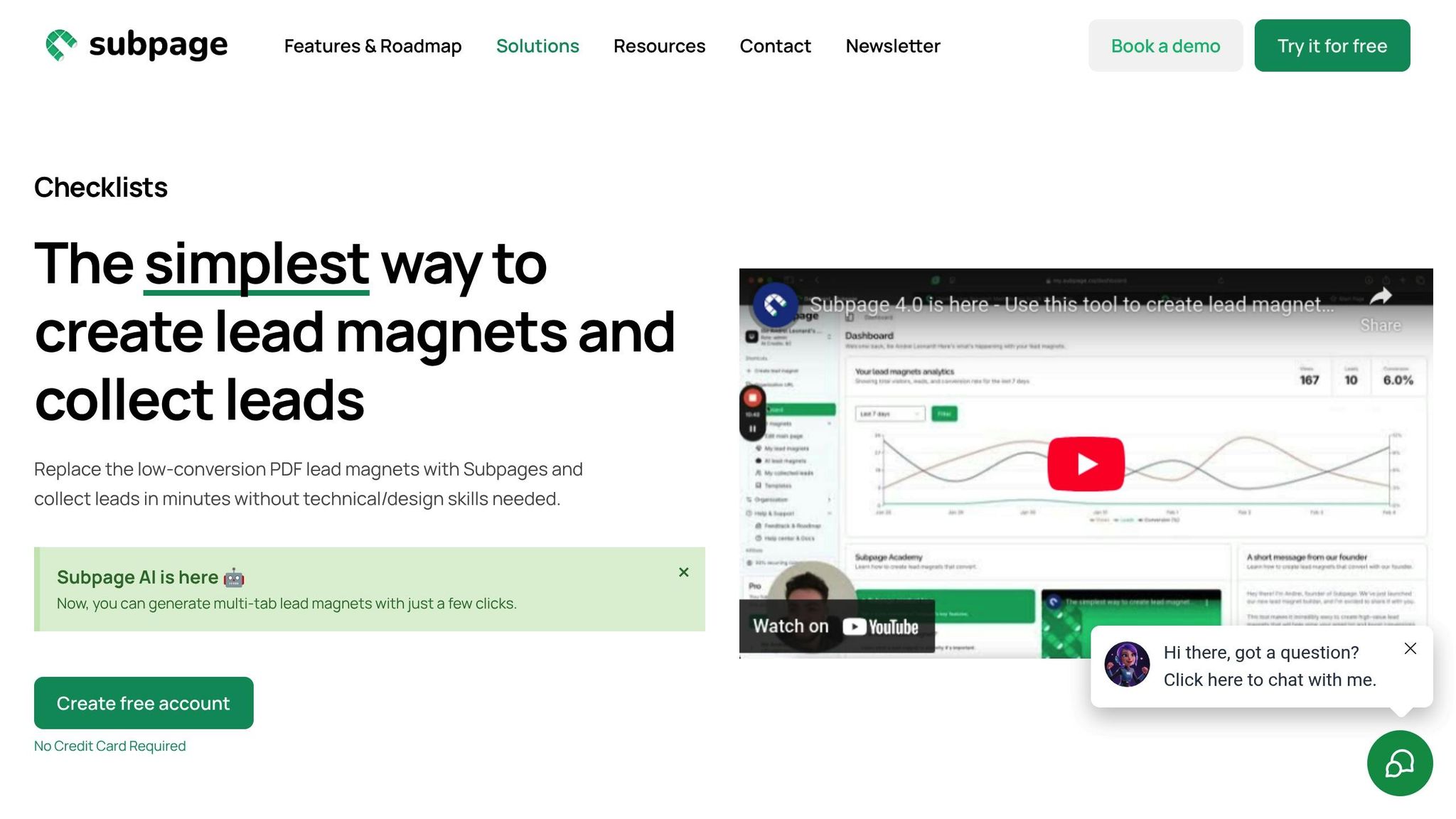Lead Magnet Analytics: What Metrics Actually Matter?

Want better results from your lead magnets? Start tracking the right metrics.
High download numbers don’t always mean success. The real win is converting those leads into paying customers. Metrics like conversion rates, lead quality, engagement, cost per lead (CPL), and lead-to-sales conversion help you measure what truly works. Focus on attracting high-quality leads who engage with your brand and align with your goals.
Here’s the key takeaway: It’s not about how many leads you generate – it’s about how many convert. Use tools like Google Analytics, Subpage.co, HubSpot, or ConvertKit to monitor performance, refine your strategies, and make data-driven improvements. Define clear goals, track the right metrics, and continuously optimize for better outcomes.
Steal This 5-Step Framework to Make Lead Magnets That Actually Convert
Key Metrics to Track for Lead Magnet Performance
Tracking the right metrics gives you a clear picture of how well your lead generation efforts are working – from grabbing attention to securing conversions. Let’s break down the key metrics and what they reveal.
Conversion Rate
The conversion rate measures how many visitors actually complete your lead capture form. To calculate it, divide the number of conversions by the total visitors, then multiply by 100. For example, if 1,000 people visit your page and 120 sign up, your conversion rate is 12%.
While benchmarks vary depending on industry and traffic sources, focus on improving factors like page load speed, the length of your form, and how clearly you communicate your offer’s value. Keep in mind, shorter forms might get you more sign-ups, but they could also limit the data you gather to assess lead quality. Striking the right balance is key.
Lead Quality
A quality lead isn’t just about numbers – it’s about attracting prospects who are genuinely interested in your product or service. Define quality based on characteristics like demographics or behaviors, such as how engaged they are with your emails or how often they interact with your website. This helps ensure your lead magnet is drawing in the right audience.
Engagement Metrics
Engagement metrics, such as email open rates, click-through rates, and the time users spend interacting with your content, can tell you a lot about your audience’s interest. By using tools like tracking pixels and analytics software, you can pinpoint which topics and formats resonate most with your prospects.
Cost per Lead (CPL)
Cost per lead (CPL) is calculated by dividing your total marketing spend by the number of leads you generate. This metric helps you gauge efficiency. Compare your CPL with your customer lifetime value to ensure your efforts are profitable. If your CPL is too high, it’s time to revisit your strategy.
Lead to Sales Conversion
This metric tracks the percentage of leads that turn into paying customers. By connecting your lead generation data to your CRM, you can see which lead magnets are driving actual revenue. This insight helps you prioritize efforts that deliver the best return on investment.
Tools for Measuring Lead Magnet Performance
Having the right tools in your arsenal can make a huge difference when it comes to tracking and improving the performance of your lead magnets. Here’s a breakdown of some top platforms that provide in-depth insights to help you refine your strategy.
Subpage.co
Subpage.co provides an all-in-one solution with real-time dashboards that monitor conversion rates, visitor behavior, and lead sources. Its integration capabilities, like Zapier and webhooks, allow seamless connections to your CRM and email tools. Plus, it includes CSV export for deeper data analysis.
A standout feature is its automated email validation, ensuring the quality of your lead data from the start. For $19 per organization per month, the Premium plan offers unlimited analytics access and integrations, making it a practical choice for marketers looking to streamline their efforts. Next, we’ll look at how Google Analytics can complement your tracking.
Google Analytics
Google Analytics is a free and powerful tool for monitoring website traffic and landing page performance. To track lead magnet downloads, you’ll need to set up conversion events in GA4, such as form submissions or file downloads.
This platform lets you dive into data by traffic source, device, and audience demographics, helping you pinpoint which channels drive the most conversions. Its goal funnel feature maps out the user journey, showing where potential leads might drop off.
Key metrics to focus on include bounce rates, time spent on the page, and conversion rates by traffic source. These insights enable you to fine-tune your landing pages and targeting strategies based on real user behavior. For more advanced tracking, HubSpot offers additional CRM integration options.
HubSpot
HubSpot goes beyond analytics by combining marketing automation with CRM tools. It tracks the entire lead journey, from the moment a lead magnet is downloaded to the final sales conversion, offering a clear picture of which assets drive the most revenue.
With features like lead segmentation, you can group prospects by behavior, demographics, or engagement levels. This allows for personalized nurturing campaigns that can significantly improve conversions. If your focus is on email tracking, ConvertKit offers specialized features worth exploring.
ConvertKit
ConvertKit specializes in tracking email subscriber engagement and automating email sequences. It provides detailed metrics, such as open rates, click-through rates, and the completion rates of automation sequences, helping you identify which lead magnets attract the most engaged subscribers.
You can monitor how subscribers interact with your emails, which calls-to-action perform best, and how many eventually become paying customers. ConvertKit’s tagging and segmentation features also make it easy to create targeted campaigns based on the specific lead magnets users download.
| Tool | Best For | Key Strengths | Starting Price |
|---|---|---|---|
| Subpage.co | All-in-one lead magnet tracking | Real-time analytics, integrations, CSV export | Free (limited) / $19/month |
| Google Analytics | Website and landing page insights | Free, detailed traffic and goal tracking | Free |
| HubSpot | Comprehensive lead management | CRM integration, lead scoring, segmentation | Free (basic) / $50+/month |
| ConvertKit | Email-focused lead tracking | Automation, subscriber engagement metrics | Free (up to 1,000) / $15+/month |
The secret to success lies in selecting tools that align with your goals and technical expertise. Many marketers find that combining these platforms creates a more complete picture of their lead magnet performance, helping them make smarter, data-driven decisions.
sbb-itb-b3a7196
How to Use Your Analytics Data
The real value of analytics lies in transforming raw numbers into actionable strategies that boost your lead magnet’s performance. By focusing on the key metrics we discussed earlier, you can turn data into meaningful improvements.
Set Key Performance Indicators (KPIs)
KPIs are the measurable targets you set to track your lead magnet’s success. Before you define these, it’s essential to establish clear goals. Are you aiming to increase brand awareness? Generate more leads? Qualify potential customers? Your objectives will determine which metrics matter most and what targets to set.
For instance, conversion rates for lead magnet sign-ups often range between 10% and 30%, based on industry benchmarks. Use this as a guide to set realistic yet challenging KPIs tailored to your business goals. The right KPIs not only help you measure success but also directly impact your ability to generate sales opportunities.
Find and Fix Performance Issues
Your analytics can highlight where your lead magnets are falling short. For example:
- Low conversion rates: This might signal issues with your messaging or landing page design. Experiment with changes to your headline, value proposition, or form placement to see if a simpler approach makes a difference.
- High bounce rates: If visitors are leaving quickly, it could mean your messaging isn’t aligned with their expectations. Double-check that your ads, emails, and blog CTAs accurately reflect the value of your lead magnet.
- High download volume but low engagement: This could indicate you’re attracting the wrong audience. Refine your content to better meet your target audience’s needs. If engagement drops during your email follow-up sequence, it’s worth revisiting your nurturing strategy to ensure it aligns with the initial content provided.
By addressing these issues, you can create a more effective, targeted approach that resonates with your audience.
Make Data-Driven Improvements
Once you’ve identified problem areas, it’s time to act. Here’s how you can use your data to make meaningful changes:
- Optimize your landing page: Use A/B testing to experiment with different headlines, images, or form placements. Tools like Subpage.co provide real-time analytics to help you quickly see what works. Test one change at a time to identify what drives improvement.
- Evaluate content formats: Look at which lead magnet types perform best with your audience. If one format consistently outshines others, focus on creating more content in that style.
- Refine your email follow-ups: If engagement drops after the first email, tweak your sending frequency or adjust the content mix to better maintain interest.
- Analyze traffic sources: Study which channels bring in not just the most leads, but the highest-quality ones. Shift resources toward those high-performing channels to maximize results.
Regularly reviewing your analytics allows you to spot trends and make small, consistent adjustments. Over time, these incremental changes can significantly improve your lead magnet’s overall performance.
Conclusion: Get Better Results with Lead Magnet Analytics
Tracking the right metrics can transform your lead magnets into a powerful engine for growth. The metrics we’ve covered give you a clear picture of how your lead magnets are performing and highlight the areas that need fine-tuning.
To recap, focus on metrics that align with what matters most to your business. For instance, a lead magnet with a modest conversion rate but attracts high-quality leads is far more impactful than one that generates a flood of unqualified contacts. Whether your aim is to boost brand visibility, capture qualified leads, or drive sales, the metrics you prioritize should reflect those goals.
Tools like Subpage.co, Google Analytics, HubSpot, and ConvertKit offer valuable insights into user behavior and how effectively you’re nurturing leads. Select platforms that work well with your existing marketing tools and provide the data you need to make smart, informed decisions. Use this data to continuously improve your lead generation efforts.
But remember, analytics are only useful if you act on them. Define clear KPIs that tie directly to your objectives, regularly measure your performance against industry standards, and adapt your approach when the numbers suggest there’s room to grow. Small, consistent changes – like adjusting your headline, refining your email campaigns, or narrowing your target audience – can lead to big improvements over time.
FAQs
How can I tell if the leads from my lead magnet are high-quality?
To assess the quality of your leads, pay attention to three main factors: engagement, lead scoring, and customer lifetime value (CLTV).
- Engagement reflects how actively a lead interacts with your content. This could include actions like opening emails, clicking on links, or downloading resources. The more engaged they are, the more likely they are to move further down your sales funnel.
- Lead scoring involves assigning a numerical value to each lead based on their behavior. Leads with higher scores typically show stronger interest or intent, making them more promising prospects.
- Customer lifetime value (CLTV) estimates the potential revenue a lead could generate over time. This metric helps you gauge not just immediate potential but also their long-term contribution to your business.
By keeping a close watch on these metrics, you can pinpoint the leads most likely to convert and drive meaningful growth for your company.
How can I boost the conversion rate of my lead magnet?
To boost your lead magnet’s conversion rate, make sure it delivers clear value to your audience. Focus on addressing a specific problem or fulfilling a pressing need. Start with a strong, attention-grabbing headline, and pair it with a visually appealing landing page that’s simple and easy to navigate.
Try out different calls-to-action (CTAs) to see which ones connect best with your audience. Simplify your opt-in form to make signing up as effortless as possible. Keep an eye on metrics like conversion rates and engagement using tools like Google Analytics or HubSpot to pinpoint what’s working and what’s not.
You could also test offering incentives, such as discounts or exclusive content, to encourage sign-ups. And don’t forget to optimize the experience for mobile users – mobile traffic accounts for a large chunk of online activity in the U.S. today.
What are the best tools to track and analyze the performance of my lead magnets?
To keep tabs on how your lead magnet is performing, you might want to use tools like Google Analytics for in-depth website data, HubSpot for marketing insights, or platforms tailored specifically for lead generation. These tools let you track crucial metrics such as conversion rates, lead quality, and engagement, giving you practical insights to refine your approach.
When selecting a tool, prioritize one that works effortlessly with your current systems and provides straightforward reporting features. A well-suited tool will make it easier to interpret data, understand your audience, and fine-tune your lead generation strategy.







